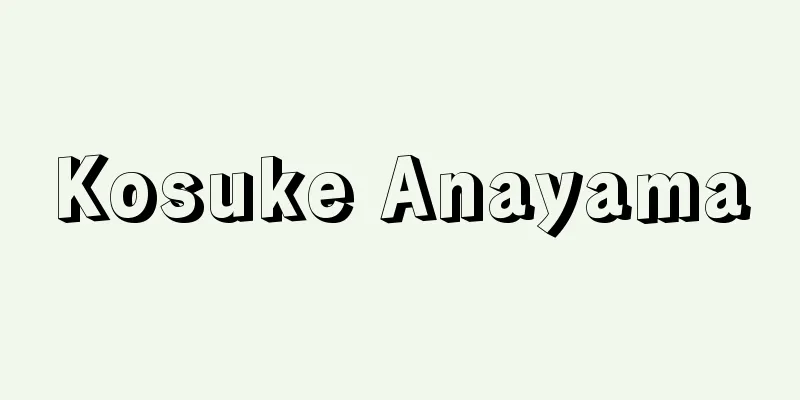Saicho - Saicho

|
The founder of the Tendai sect in Japan. He was posthumously named Dengyo Daishi, and is also known as Choshonin, Eizan Daishi, Konpon Daishi, and Sange Daishi. He was born in Furuichi-go (Sakamoto Honmachi, Otsu City) at the foot of Mount Hiei as the son of Mitsunoobi Tomomoe (some say Kyoshi, or Jyosoku), a member of the royal family of the Later Han Dynasty of China who is said to be a descendant of a naturalized person around the time of Emperor Ojin. His childhood name was Hirono. In 780 (Hōki 11), he became a monk under Gyōhyō of Kokubunji Temple in Omi (Shiga Prefecture), and was taught that "one should return one's mind to the One Vehicle." In 785 (Enryaku 4), he received full precepts at the Kaidan of Todaiji Temple and became a promising nationally recognized monk, but soon after, he avoided the Buddhism of Nara and climbed Mount Hiei to train, where he read many sutras and commentaries, learned about the superiority of Tendai teachings, and sought out and studied Tendai classics. After entering the mountain, Saicho, seeing the impermanence of the world and feeling ashamed of his own immaturity, made five vows to realize his Buddhist training ("Ganmon") and vowed not to come down from the mountain until they were fulfilled. This was later institutionalized as the "Twelve Years of Seclusion on the Mountain" rule for monks' training and remains in place to this day. During this time, he founded Ichijo Shikan-in (the precursor to the Konponchudo) on Mount Hiei, carved a life-size statue of Medicine Buddha, and is said to have composed the poem, "Buddhas of Anuttara-samyaku-sambodhi, please bless the woodland where I stand." He also dedicated the lamp of the Law to this hall, saying, "May the light of the Law shine even in the future world of Buddha," and has kept the lamp of the Law burning to this day. In 797, he was added to the Ten Zen Masters of the Interior, and in November of the following year, 798, he held the first ten lectures on the death anniversary of Tendai Chisha Daishi (the present Shimotsukie). In 802, he was invited by Wake no Kiyomaro's sons Hiroyo and Matsuna (783-846) to come down from the mountain for the first time and gave a lecture on the three major parts of the Lotus Sutra - "Makashikan," "Hokke Gengi," and "Hokke Mongu" - at Takaosan-ji Temple (Jingo-ji Temple) in Kyoto. Many great virtuous people from Nara attended and praised his lecture. [Yoshimichi Shioiri July 19, 2017] Entering China and the Founding of Tendai BuddhismIn September 802, in response to his earlier petition to travel to China to seek the teachings of the Lotus Sutra, he received imperial permission to travel to China as a Tendai Hokke sect student and in July 804, he set sail from Tanoura in Hizen (Nagasaki Prefecture) accompanied by the translator Gishin. Incidentally, Kukai was also on this mission to China, but when they arrived in Fuzhou, they parted ways without any exchange of words, and Saicho and his party arrived in Mingzhou on September 1. On September 26, Saicho arrived in Taizhou, where he learned Tendai doctrine from the head priest Gyoman (?-824) at Shuzenji Temple on Mount Tiantai, and from the monk Dozui (date of birth and death unknown) at Ryukoji Temple in Taizhou, and was also given the Mahayana Bodhisattva precepts from Dozui. He also received the Gozu Zen method from Zen Master Shukunen (date of birth and death unknown) of Zenrin-ji Temple, and esoteric Buddhism from Junkyo Ajari (date of birth and death unknown) of Ryuko-ji Temple in Etsushu. In just eight months, he brought back 120 volumes and 345 volumes from Mount Tendai (Taishu-roku) and 102 volumes and 115 volumes of esoteric Buddhism texts from Etsushu (Etsushu-roku), and returned to Tsushima in June 805. After returning to Japan, he performed the first abbot's chant in Japan at Takao-san-ji Temple in September of the same year. He also petitioned for two official monks (nenbundosha) to be allocated to the Tendai Hokke sect in addition to the Nara Six sects, and was granted imperial permission on January 26, 806. This was, so to speak, official national recognition, and this day marks the founding of the Japanese Tendai sect. [Yoshimichi Shioiri July 19, 2017] Dispute with TokuichiIn 814 (Kōnin 5), he made a journey of thanks to the gods of Tsukushi (Fukuoka Prefecture) and Buzen (Oita Prefecture) for whom he had prayed before setting out for China. The following year, 815, he made a tour of Kozuke (Gunma Prefecture) and Shimotsuke (Tochigi Prefecture) and built a pagoda to house 1,000 copies of the Lotus Sutra to protect the nation. This wish for the security of Japan became the Rokusho Hōtō Ganmon (818), a prayer to build six pagodas throughout the country. He also built two temples, Kōsai and Kōjō, at the foot of the difficult Kamisaka Pass on the way from Mino (Gifu Prefecture) to Shinano (Nagano Prefecture), to make it easier for travelers to get around. Around this time, Tokuitsu of the Hosso sect, who lived in Aizu (Fukushima Prefecture), criticized the Tendai doctrine and wrote "Busshosho," in response to which Tokuitsu refuted it with "Shogonjikkyo" in 817. He then refuted Tokuitsu's refutations, such as "Chuhengikyo," "Enichiusoku," and "Shaikensho," by writing "Hokkekowaku," "Tsurokukyushohahiryomon," and "Shugokokaisho." This was a debate between the Hosso sect's Three Vehicles philosophy and the Tendai sect's One Vehicle philosophy, and is known in the world as the "Three One Gonjitsu Dispute." Debates continued until Saicho's death, but "The Lotus Sutra Shuku" marked the conclusion of the debate over the validity of the teachings in the year before his death. [Yoshimichi Shioiri July 19, 2017] Independence of the Mahayana Ordination PlatformDue to the dispute with Tokuitsu and the Ehyō Tendai Gishu (813), conflict arose with Nara Buddhism, especially with the Hosso sect, and of the 24 Nenbundosha who had been approved earlier, four were fought over by the Hosso sect for ten years from 807 (Daido 2), leaving only ten resident mountain monks. At that time, the ten Nara Nenbundosha and the two Tendai sect monks were all under the supervision of a government-appointed sōgō (sōgō), and were to receive the 250 precepts, which had been passed down since India, at the ordination platforms of Todai-ji Temple in Nara, Yakushi-ji Temple in Shimotsuke (Tochigi Prefecture), and Kanzeon-ji Temple in Tsukushi (Fukuoka Prefecture). Saichō considered these to be Hinayana precepts, and argued that since the teachings were Mahayana Buddhism, the precepts should also be Mahayana precepts. In 818, he petitioned for the bodhisattva ordination and submitted the Tendai Hokke Sect Annual Student Ceremony (Rokujoshiki) and the Encouragement Tendai Sect Annual Student Ceremony (Hachijoshiki), which contained the educational system for Tendai sect annual students in Shikan-gyo (Tendai Buddhism) and Shana-gyo (Esoteric Buddhism). In the following year, 819, he submitted the Tendai Hokke Sect Annual Student Ceremony (Eshokodaishiki) (Shijoshiki), which requested the independence of Mahayana precepts. These three ceremonies are collectively called the Sange Student Ceremony. In this book, Saicho aimed to train annual students as bodhisattva monks. However, he encountered strong opposition from Nara Buddhism including Gomyōsōzu, and in response he presented the "Kenkairon" and "Kenkairon Engi," which discussed the basis of the Shijo-shiki and the orthodoxy of the Mahāyāna precepts, as well as the "Naishō Buppo Sōshō Kechimyakufu," a tradition of the Tendai sect's Enkai Zenmitsu school. However, these were not realized during his lifetime, and on June 4, 13th year of the Kōnin era, he passed away at Chudo-in on Mount Hiei, leaving this will: "Do not create a Buddha for me, do not copy sutras for me, but state my wishes." Seven days later, with the help of Fujiwara no Fuyutsugu and Yoshimine no Yasuyo, imperial permission was granted to build a platform for Mahayana ordination, and the following year, 823, Yoshizane was the first person in Japan to receive the formal Mahayana ordination, and the temple was given the name Enryaku-ji. In 866 (Jogan 8), Emperor Seiwa bestowed the posthumous title of Dengyo Daishi, the first posthumous title in Japan. [Yoshimichi Shioiri July 19, 2017] "The Complete Works of Dengyo Daishi, vol. 5, compiled by the Tendai Sect Classics Publishing Association (republished in 1968, Nakayama Shobo)" ▽ "Japanese Thought Series 4: Saicho, annotated by Ando Toshio and Sonoda Koyu (1974, Iwanami Shoten)" ▽ "Dengyo Daishi, by Shioiri Ryotada (1929, Nippon Hyoronsha) " ▽ "Mount Hiei and Mount Koya, by Katsuno Takanobu (1959, Shibundo)" ▽ "A New Wind on Mount Hiei, by Mibu Daishun (1967, Chikuma Shobo)" ▽ "The Life and Thought of Dengyo Daishi, by Kiuchi Hiroshi (Daisanbunmeisha, Regulus Bunko)" [References] | | | | | | | sect | |Old type edition, Volume 1, by Saicho, published in 1617 (Genwa 3), owned by the National Diet Library "The Theory of Revealing Precepts" Source: Shogakukan Encyclopedia Nipponica About Encyclopedia Nipponica Information | Legend |
|
日本天台宗の開祖。伝教大師(でんぎょうだいし)と諡号(しごう)され、澄上人(ちょうしょうにん)、叡山(えいざん)大師、根本(こんぽん)大師、山家(さんげ)大師とも称される。 中国後漢(ごかん)の王族で応神(おうじん)帝ころの帰化人の子孫と伝える三津首百枝(みつのおびとももえ)(一説に巨枝=浄足(きょし))の子として比叡山麓(ひえいさんろく)古市(ふるいち)郷(大津市坂本本町)に生まれ、幼名を広野という。780年(宝亀11)近江(おうみ)(滋賀県)国分寺の行表(ぎょうひょう)を師として出家、「心を一乗に帰すべし」との教えを受ける。785年(延暦4)東大寺戒壇(かいだん)で具足戒(ぐそくかい)を受け前途有望の国家公認の僧となったが、ほどなく南都の仏教を避けて比叡山に登り修行、多くの経論を読んで天台教学の優れたことを知り、天台典籍を求めて学んだ。入山後の最澄は、世の無常を見つめ自己の未熟を恥じ、仏道修行を実現するための五つの誓願をたて(『願文(がんもん)』)、それが成就するまで下山しないと誓った。これはのちに僧の修行の規則「十二年籠山(ろうざん)」として制度化され現在に至っている。この間、比叡山に一乗止観院(いちじょうしかんいん)(根本中堂の前身)を創建し、等身の薬師如来(やくしにょらい)像を刻み、「阿耨多羅三藐三菩提(あのくたらさんみゃくさんぼじ)の仏(ほとけ)たち、我(わ)が立つ杣(そま)に冥加(めか)あらせ給(たま)え」と詠じたと伝える。またこの堂に献じた法燈(ほうとう)を「明らけくのちの仏のみ世までも、光りつたえよ法(のり)のともしび」とし、現在まで不滅の法燈をともす。797年内供奉(ないぐぶ)十禅師に加えられ、翌798年11月には天台智者大師の忌日法華(ほっけ)十講(現在の霜月会(しもつきえ))を始修した。802年和気清麻呂(わけのきよまろ)の子広世(ひろよ)・真綱(まつな)(783―846)に招かれて初めて山を下り、京都高雄山寺(たかおさんじ)(神護寺)において『摩訶止観(まかしかん)』『法華玄義(ほっけげんぎ)』『法華文句(もんぐ)』の法華三大部の講義を行い、南都の諸大徳も列席しその講を称賛したという。 [塩入良道 2017年7月19日] 入唐と天台宗の開宗802年9月、先に上奏した入唐求法(にっとうぐほう)の請願に対し、入唐請益(じょうやく)天台法華(ほっけ)宗還学生(げんがくしょう)の勅許が下り、804年7月に訳語僧義真(ぎしん)を伴い肥前(長崎県)田浦(たのうら)から出帆した。ちなみに、この遣唐使節団には空海も同行していたが、福州に着くと互いに交渉のないまま別れ、最澄一行は9月1日明州に着いた。9月26日台州に至った最澄は、天台山修禅寺(しゅぜんじ)で行満(ぎょうまん)座主(?―824)から、台州竜興寺で道邃(どうずい)和尚(生没年不詳)から天台教義を学び、また道邃から大乗菩薩戒(ぼさつかい)を授かった。さらに禅林寺翛然(しゅくねん)禅師(生没年不詳)から牛頭(ごず)の禅法、越州竜興寺順暁阿闍梨(じゅんぎょうあじゃり)(生没年不詳)からは密教を授かり、わずか8か月余の間に天台山での120部345巻(『台州録』)、越州での密教典籍102部115巻(『越州録』)を請来(しょうらい)して、805年6月対馬(つしま)に帰着した。帰朝後、同年9月に高雄山寺で日本で初めての灌頂(かんじょう)を実施した。また南都六宗に加えて天台法華宗にも正式の僧の割り当て(年分度者(ねんぶんどしゃ))2人を請願し、806年1月26日勅許が下った。いわば国家的な公認を受けたこととなり、この日を日本天台宗の開宗とする。 [塩入良道 2017年7月19日] 徳一との論争814年(弘仁5)、入唐出発にあたり渡海祈願した筑紫(つくし)(福岡県)、豊前(ぶぜん)(大分県)の神々に謝恩の旅をし、翌815年は上野(こうずけ)(群馬県)、下野(しもつけ)(栃木県)に巡化して鎮護国家のため『法華経』1000部を納める宝塔を建立した。この日本国安鎮の願は、全国に六所の宝塔をつくることを発願した『六所宝塔願文(ろくしょほうとうがんもん)』(818)となった。また美濃(みの)(岐阜県)から信濃(しなの)(長野県)への難所神坂(かみさか)峠の登り口にそれぞれ広済(こうさい)・広拯(こうじょう)2院を建て旅人の便を図った。このころ会津(あいづ)(福島県)にいた法相宗(ほっそうしゅう)の徳一(とくいつ)が天台教義を批判して『仏性鈔(ぶっしょうしょう)』を著したのに対し、817年『照権実鏡(しょうごんじっきょう)』をもって反論し、続いて徳一の反駁(はんばく)書『中辺義鏡(ちゅうへんぎきょう)』『恵日羽足(えにちうそく)』『遮異見章(しゃいけんしょう)』などに対し、『法華去惑(こわく)』『通六九証破比量文(つうろくきゅうしょうはひりょうもん)』『守護国界章(しゅごこっかいしょう)』などを著して再反駁した。これは法相宗の三乗思想と天台宗の一乗思想の論争で、世に「三一権実論争」といわれる。最澄が亡くなるまで論義が交わされたが、『法華秀句(しゅうく)』は入滅前年の権実論争の決着であった。 [塩入良道 2017年7月19日] 大乗戒壇の独立徳一との論争や『依憑(えひょう)天台義集』(813)などにより南都仏教とくに法相宗との対立が生じ、先に認可された年分度者も、807年(大同2)から10年間は24人中4人は法相宗に争奪され、住山僧10人という状況となった。また当時の年分度者南都10人、天台宗2人は、いずれも官から任命された僧綱(そうごう)の管下で、奈良東大寺、下野(しもつけ)(栃木県)薬師寺(やくしじ)、筑紫(つくし)(福岡県)観世音寺(かんぜおんじ)の戒壇で、インド以来の二百五十戒を受ける定めであった。最澄はこれを小乗戒とし、教法が大乗仏教であるから戒も大乗戒でなければならぬと主張した。818年に菩薩出家を請う表と、天台宗の年分度者の止観業(しかんごう)(天台仏教)と遮那業(しゃなごう)(密教)の教育制度を内容とする『天台法華宗年分学生式(がくしょうしき)』(六条式)、『勧奨(かんしょう)天台宗年分学生式』(八条式)を上奏し、翌819年は大乗戒の独立を願う『天台法華宗年分度者回小向大式(えしょうこうだいしき)』(四条式)を上表した。この三式を総称して『山家(さんげ)学生式』とよぶ。最澄はこの書において年分度者を菩薩僧として育成することを目的とした。 しかし、護命僧都(ごみょうそうず)ら南都仏教の強い反対にあい、この反論として四条式の根拠と大乗戒の正統性を論じた『顕戒論(けんかいろん)』『顕戒論縁起』や、天台宗の円戒禅密(えんかいぜんみつ)の伝承『内証仏法相承血脈譜(ないしょうぶっぽうそうしょうけちみゃくふ)』を奉ったが、生存中にはついに実現せず、弘仁(こうにん)13年6月4日、「わがために仏をつくることなかれ、わがために経を写すことなかれ、わが志を述べよ」と遺言して比叡山の中道院で入滅。その7日後に藤原冬嗣(ふじわらのふゆつぐ)、良岑安世(よしみねのやすよ)の斡旋(あっせん)で大乗戒壇建立の勅許が下り、翌823年義真によって日本で初めて正式の大乗戒の受戒が行われ、延暦寺(えんりゃくじ)の寺号を賜った。さらに866年(貞観8)清和(せいわ)天皇から伝教大師の諡号が贈られたが、これが日本の諡号の最初である。 [塩入良道 2017年7月19日] 『天台宗宗典刊行会編『伝教大師全集』5巻(再刊・1968・中山書房)』▽『安藤俊雄・薗田香融校注『日本思想大系4 最澄』(1974・岩波書店)』▽『塩入亮忠著『伝教大師』(1929・日本評論社)』▽『勝野隆信著『比叡山と高野山』(1959・至文堂)』▽『壬生台舜著『叡山の新風』(1967・筑摩書房)』▽『木内央著『伝教大師の生涯と思想』(第三文明社・レグルス文庫)』 [参照項目] | | | | | | | | |古活字版 巻上 最澄著 1617年(元和3)刊国立国会図書館所蔵"> 『顕戒論』 出典 小学館 日本大百科全書(ニッポニカ)日本大百科全書(ニッポニカ)について 情報 | 凡例 |
<<: Local government officials - Zaichoukanjin
>>: Hornbill (Rhino) - Hornbill (English spelling)
Recommend
Acystopteris japonica (Luerss.) Nakai
A delicate and beautiful medium-sized fern that gr...
Yokoi Chiaki
1738-1801 A Japanese classicist from the mid to l...
Okatora no O - Okatora no
A perennial plant of the Primulaceae family (APG ...
Aschizomys regulus (English spelling)
…[Tadaaki Imaizumi] [Yoshinori Imaizumi]. … *Some...
Picnic - picnic (English spelling)
There are various meanings for picnics, such as f...
Amoghapāśa - Fukukensakukannon (English)
One of the six Kannon. One of the statues at Taizo...
Rocinela maculata (English spelling) Rocinela maculata
...They live on the deep sea floor and attach to ...
Litsea acuminata (English spelling) Litsea acuminata
… [Ken Ogata]. . … *Some of the terminology that ...
Mr. Anayama
Medieval samurai of Kai. A branch of the Takeda cl...
Phoeniconaias minor
…They breed in the Andean lakes from Peru to sout...
Romany
...Gypsies themselves call themselves rom, roma (...
Hémon, Louis
Born: October 12, 1880 in Brest [Died] July 8, 191...
Meteorological information - weather information; meteorological information
Weather information is issued from time to time to...
Gynogenesis
...And even if the sperm of other subspecies of c...
Cart (Plants) - Cart
Yemen's coffee, beloved under the name of Moc...









